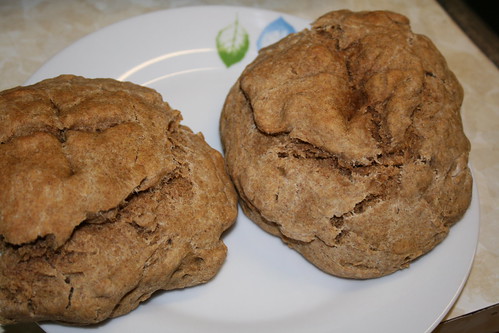Ingredients:
3 cups of whole wheat flour
1 cup of white all purpose flour
2 tsp baking soda
2 tsp salt
1/3 cup canola oil
1 3/4 cup buttermilk
Directions:
1. Preheat oven to 350 degrees.
2. Combine dry ingredients in a large mixing bowl.
3. Mix buttermilk and oil. Make well in centre and add about 3/4 cups of buttermilk and oil mixture.
4. Mix together with floured hands.
5. Add the rest of the buttermilk and oil until mixture becomes soft dough.
6. Turn onto lightly floured counter and knead 8 to 10 times gently shaping the dough into a ball.*
7. Place ball of dough on a greased baking sheet, and press into a circle about 2 1/2 inches deep.
8. Cut a large cross in the centre about 1/4 inch deep.
9. Bake in oven at 350 degrees from 40 minutes to an hour, and check to see if it is using a knitting needle or a toothpick. If it comes out clean, it’s ready!
10. Cool on a wire rack.
11. Enjoy a slice or two with butter and jam, and save the rest in a bread tin to keep it fresh.
*I decided to make two mini loaves instead
(Recipe donated by Kathleen Wetherall)

The smell of wheaten bread baking is the smell of my grandmother in the house.
When I was sixteen and moved to Northern Ireland for a year, I found that wheaten bread was everywhere. While in a small city just outside of Belfast, I was served the hearty Irish bread with breakfast, lunch, and even dinner. I quickly realized that the bread isn’t only good in the morning, but that it goes beautifully with a hearty Irish stew on a cold evening. And while I was unimpressed with most Irish cuisine, I quickly grew fond of some of the local breads: potato bread, a flat bread made on a griddle called farl, and of course, wheaten.
My grandmother grew up on a farm in Northern Ireland, where her mother made wheaten bread with a cake-like texture she's never been able to replicate. She made the bread herself for the first time in technical college, and collected several different recipes before she decided how to perfect her own. It wasn’t long before her own children, five girls and one boy, were enjoying her many varieties of wheaten. “Kids love it,” says my grandmother, who sometimes adds dried fruit and golden raisins (“They taste much better than the ordinary raisins,” she points out).
Northern Ireland is never to be mistaken with the Southern Ireland. One is British, one is European, one carries the pound, one uses the Euro, and they both have different names for the country’s favourite bread. What we know as wheaten bread in the North is referred to as soda bread in the South. It is called soda bread because yeast is substituted with baking soda in the bread’s dough. The cold and wet climate of Ireland is best for growing hard wheat, and the flour rises with the help of baking soda. The cross cut in wheaten bread is rumoured to ward off evil, but is most likely there to help it bake properly.
Irish wheaten bread only stays fresh for a few days, so it’s important to store it away in a tight container. It’s even more important to toast it just lightly enough to warm it up, and to put a healthy helping of raspberry or strawberry jam on top.
To this day, the bread reminds me of my childhood and also my heritage. It makes me think of my mom, my grandmother and I all in our bathrobes, standing in the kitchen eating toasted wheaten bread. It makes me think of my great aunt in Northern Ireland, putting out trays of wheaten bread and sharp aged cheddar for us to eat with hot tea.
Something as simple as a recipe can tie one generation to another. It can represent family, familiarity, nationality and more. A huge part of who I am and where I come from can be tasted in a warm slice of bread.





















